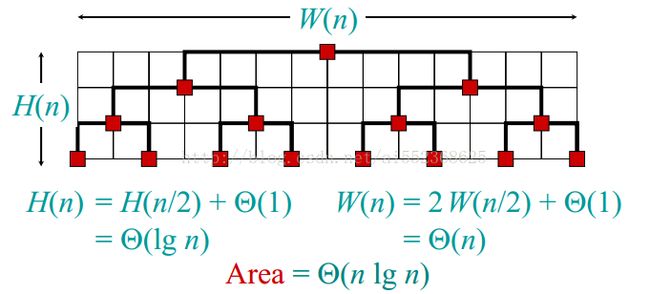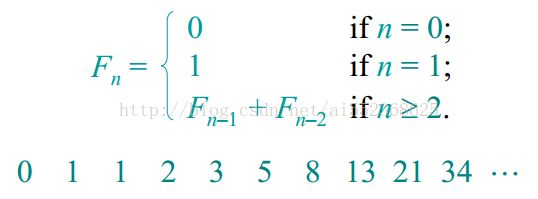MIT算法导论学习笔记-Lecture3:分治法
第三讲 分治法(Devide and Conquer)
思想:大问题分解成小问题,各个击破
步骤:
Step1:Devide——大问题分解成小的问题,e.g.大小为n的问题分解为n/2的问题
Step2:Conquer——(递归地)解决小问题
Step3:Combine——将解合并
e.g. 归并排序
Step1:Devide——将待排序的序列分成两个子序列
Step2:Conquer——(递归地)对每个子序列进行排序
Step3:Combine——将排序好的子序列合并
时间复杂度:
T(n) = 2T(n/2) + Theta(n)
Master Method—>case2,k=0,得到T(n) = Theta(nlgn)
—3.1二分查找(Binary Search)
Step1:Devide——将x与序列的中间元素比较Step2:Conquer——(递归地)在子有序数列中查找xStep3:Combine——nothing
时间复杂度:
T(n) = T(n/2) + Theta(1),即T(n) = Theta(lgn)
// binary search, if so return the position,else return -1
// Non-Recursive version.
int BinarySearch(int *Array,int x,int L) //L is the length of the sorted array
{
int low, mid, high ;
low = 0 ;
high = L - 1 ;
//mid = (low + high + 1)/2 ;
while (low < high)
{
mid = (high + low + 1)/2 ;//the index is not right
if (Array[mid] == x)
{
return mid ;
}
else if (Array[mid] < x)
{
low = mid + 1;
}
else
{
high = mid - 1;
//mid = (high + low + 1)/2 ;
}
}
return -1;
}// binary search, if so return the position,else return -1
// Recursive version.
int BinarySearchRecursive(int *Array,int x,int Low,int High) //L is the length of the sorted array
{
int mid;
mid = (Low + High + 1)/2 ;
if (Low < High)
{
if (Array[mid] < x)
{
Low = mid + 1 ;
return BinarySearchRecursive(Array,x,Low,High) ;
}
else if (Array[mid] > x)
{
High = mid - 1;
return BinarySearchRecursive(Array,x,Low,High) ;
}
else
return mid ;
}
else
return -1 ;
}虽然该算法是一个递归运算,但显然非递归方法更容易理解.本文给出了二分查找的简单实现,程序参照了如下博客:http://blog.csdn.net/yangtrees/article/details/8898997关于二分查找更详尽的讨论,可以参照如下博客:http://www.cppblog.com/converse/archive/2009/10/05/97905.html
—3.2幂次方问题 (Powering a Num)
问题描述:给定一个数x(int/float),和一个正整数n,求x^n
3.2.1 基本实现方法
即,将x相乘n-1次,代码为:
DataType PoweringNum(DataType x, int n)
{
DataType ans = x;
for (int i = 1; i < n; i ++)
{
ans *= x ;
}
return ans ;
}该方法的时间复杂度为:T(n) = Theta(n),即线性的。
3.2.2 二分法:
实现方法如下图:
时间复杂度:
T(n)= T(n/2) + Theta(1),即T(n) = Theta(lgn)
该算法的一个简单代码实现为:
DataType PoweringNumRecursive(DataType x, int n)
{
DataType ans = 0 ;
if ( n > 1 && 0 == n%2) // n is an even num
{
n /= 2 ;
ans = PoweringNumRecursive(x,n) ;
return ans*ans ;
}
else if(n > 1)
{
n /= 2 ;
ans = PoweringNumRecursive(x,n) ;
return ans*ans*x ;
}
else
{
return x ;
}
}—3.3斐波那契数列(Fibonacci Num)
问题描述:
3.3.1 基本方法——递归法
该方法要计算Fn,则计算Fn-1和Fn-2,etc。该方法的时间复杂度为:T(n) = Omega(q^n),q = (1 + sqrt(5))/2,即黄金分割点,即该方法是指数级的时间复杂度。
简单代码:
//Fibonacci num int FibonacciNum(int n) { if(n >= 2) { return FibonacciNum(n-1) + FibonacciNum(n-2) ; } else { return n ; } }
3.3.2 Bottom-Up法(从头到尾)
思想:按顺序计算Fn,则每个Fn只需要计算一次,下一次可以用上一次的计算结果,这样改进后算法的时间复杂度就降低为线性时间复杂度,即T(n) = Theta(n)
简单代码:
int FibonacciNum_BottomUp(int n) { int ans ; if (n < 2) { ans = n ; } else { int a0 = 0, a1 = 1 ; int i = 2 ; while (i <= n) { ans = a0 + a1 ; a0 = a1 ; a1 = ans ; i ++ ; } } return ans ; }
3.3.3 平方递归法
1). 朴素平方递归法
该方法用到Fibonacci数列的一个性质,即
Fn= [q^n/sqrt(5)],q为上面提到的黄金分割点,[a]表示离a最近的整数。
该方法的时间复杂度与上面求幂次方的时间复杂度相同,即T(n) = Theta(lgn)
该方法理论上是可行的,但是实际应用时却会遇到问题,即浮点运算容易出现舍入误差,而且据我所知,C语言中没有专门的取最近整数的函数。
2).平方递归法
该方法用到Fibonacci数列的另一个性质,即:
该性质在理论上和实际上都是可行的,其时间复杂度为:T(n) = Theta(lgn)
int *MatrixMulMatrix_2x2(int const a[4],int const b[4])//row major store { int *c ; c = (int *)malloc(4*sizeof(int)) ; c[0] = a[0]*b[0] + a[1]*b[2] ; c[1] = a[0]*b[1] + a[1]*b[3] ; c[2] = a[2]*b[0] + a[3]*b[2] ; c[3] = a[2]*b[1] + a[3]*b[3] ; return c ; } int *FibonacciNum_PowerRecursive(int n,int input[4]) { int *output ; output = (int *)malloc(4*sizeof(int)) ; int *output1 ; output1 = (int *)malloc(4*sizeof(int)) ; if ( n > 1 && 0 == n%2) // n is an even num { n /= 2 ; output1 = FibonacciNum_PowerRecursive(n,input) ; output = MatrixMulMatrix_2x2(output1,output1) ; return output ; } else if(n > 1) { n /= 2 ; output1 = FibonacciNum_PowerRecursive(n,input) ; // Repeated use of output1 and output. output = MatrixMulMatrix_2x2(output1,output1) ; output1 = MatrixMulMatrix_2x2(output,input) ; return output1 ; } else if(1 == n) { return input ; } // Take n = 0 into consideration. else { input[1] = 0 ; input[2] = 0 ; return input ; } }
注意:上面实现中,2x2矩阵用一个一位数组按行优先来存储,这样Fn即为输出一位数组的output[1]或者output[2];另一个需要注意的是,该方法不适用于n=0的情况,由上图定义很好理解,n=0时Fn-1无意义,但是由于我们只关心的是output[1]或者output[2]的正确与否,所以程序实现时在最后一个else里面考虑了该种情况,即通过将input对应的值改变包括该情况。
—3.4 矩阵乘法(只考虑方阵)
矩阵乘法是一个相对来说比较困难的问题,所需篇幅较大;而且Strassen矩阵相乘这种经典算法,值得专门写一篇来讨论,所以矩阵相乘将放在下一篇来讨论。
—3.5 分治法解决VLSI layout(VeryLarge Scale Integration,超大规模集成电路布局问题)
问题描述:怎样将一个n个叶子的完全二叉树布局,使得所占用面积最小?
想了好久,加不加入这一小节,还是加上吧。原因有二:一这样可以与视频匹配;二这种分治法用到VLSI中,为什么最开始不是我们想到的呢?这种创新性是怎么来的呢?由此可以看到国外的在这种发散思维上还是比我们要做的好。
3.5.1 基本实现方法

上图可以说是一个最naïve的想法,则n个叶子的完全二叉树,其占的高度为H(n) = Theta(lgn),占用的宽度为W(n) = Theta(n),占用面积为Area = Theta(nlgn).
怎么样使其变成线性复杂度呢???
3.5.2 H布线法

对其分析,从图上一眼就能看明白。然而,最重要的不是这个想法有多巧妙,而是分治法的思想是怎样运用的。
要想得到一个线性复杂度的面积,则需要长宽(假设为矩形)的复杂度之乘积为线性的,那么最基本的想法是:
有了这个目标函数(也可以说Area =Theta(n)为目标函数),怎么计算呢??这便用到了上一讲的 Master Method,即W(n) = H(n) = Theta(sqrt(n))
式中,e为一个小的数,第二项表示的意思是时间复杂度小于n^(1/2)T(n)= aT(n/2a) + O(n^(1/2-e))
根据Master Method,case1,上式的时间复杂度显然为Theta(n)
那么,最简单的a=2,这便得到了上图中的方法,当然由该公式得到上面布线的idea还需要经验等等,但是这种由目标函数来反推解决方法总比盲目地尝试要来得快得多。
由此可见,这种看似简单的分治法,真正达到了融会贯通也将大有用处的。


